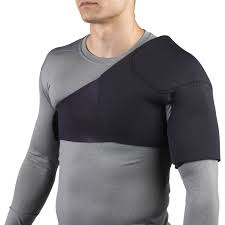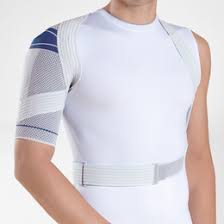The Impact of Shoulder Compression Sleeves on Athletic Performance
In the world of competitive sports, especially for baseball enthusiasts, every edge counts. Whether it’s perfecting a swing or refining a pitch, athletes constantly seek ways to enhance their performance while minimizing injury risks. One such innovation that’s gaining traction is the shoulder compression sleeve. While these garments might appear as mere accessories, their benefits go far beyond aesthetics.
Unveiling the Shoulder Compression Sleeve
A shoulder compression sleeve is a specialized form of compression gear designed to provide targeted support and relief to the shoulder area. Crafted from a blend of elastic materials such as spandex and nylon, these sleeves offer a snug fit that extends from the upper arm to the shoulder. This design ensures a consistent application of gentle pressure, which plays a crucial role in enhancing athletic performance and recovery.
How Shoulder Compression Sleeves Enhance Performance
The core functionality of a shoulder compression sleeve lies in its ability to apply controlled pressure to the shoulder area. This pressure helps constrict the veins and arteries, thereby promoting better blood circulation. As a result, oxygen-rich blood reaches the muscles more efficiently, while waste products like lactic acid are swiftly removed. This improved circulation can lead to increased endurance, reduced muscle fatigue, and quicker recovery times—key factors for athletes who push their bodies to the limit.
Historical Perspective and Evolution
The concept of compression garments is not new; they have been used for medical purposes for decades. Historically, compression socks have been prescribed to manage conditions like deep vein thrombosis and varicose veins. The technology has evolved, and now compression garments, including shoulder sleeves, are tailored to meet the needs of athletes. This evolution underscores the garment’s dual role in both medical and athletic contexts.
The Benefits of Shoulder Compression Sleeves
- Injury Prevention and Support: Shoulder compression sleeves offer valuable support to the rotator cuff and surrounding muscles, which are often subjected to strain in sports like baseball. By stabilizing the shoulder joint and reducing muscle vibration, these sleeves can help prevent injuries and mitigate discomfort.
- Enhanced Athletic Performance: With improved blood flow, athletes experience enhanced muscle function and stamina. The sleeve’s support can help athletes perform at their peak, whether it’s executing a powerful throw or maintaining endurance throughout a game.
- Accelerated Recovery: Post-exercise recovery is crucial for maintaining peak performance. Shoulder compression sleeves aid in reducing muscle soreness and inflammation, allowing athletes to recover faster and return to training with less downtime.
Practical Applications in Sports
For baseball players, the shoulder compression sleeve is particularly beneficial. The repetitive motion of pitching and batting places significant stress on the shoulder. A well-designed compression sleeve can alleviate some of this strain, offer warmth to the muscles, and aid in quicker recovery between games or practice sessions.
Exploring Options: BRUCE BOLT Shoulder Compression Sleeves
At BRUCE BOLT, our shoulder compression sleeves are engineered to deliver superior support and comfort. Made from breathable, high-quality materials, our sleeves ensure that athletes experience both functionality and comfort. Whether you’re aiming to enhance your game or recover from a recent injury, our sleeves provide the necessary support to keep you performing at your best.
Compression Sleeves and Garments for Lymphedema: Enhancing Relief and Management

Lymphedema, a condition characterized by the accumulation of lymphatic fluid, can lead to significant swelling and discomfort in the affected areas. Effective management of lymphedema often involves the use of compression sleeves and garments, which play a crucial role in alleviating symptoms and improving quality of life.
The Role of Compression in Lymphedema Management
Compression sleeves and garments are designed to exert pressure on the affected areas, helping to move accumulated fluids away and reduce swelling. These specialized garments are made from elastic fabrics that apply consistent pressure to the skin, aiding in the drainage of excess lymphatic fluid.
Types of Compression Garments
- Lymphedema Compression Sleeves: These are worn on the arms to manage swelling. They are crafted to fit snugly, applying graded pressure from the wrist to the upper arm to promote lymphatic flow.
- Fingerless Gloves or Gauntlets: These are often used in conjunction with arm sleeves. They provide additional compression to the hand and fingers, especially in cases where swelling extends beyond the arm.
- Support Bras: Designed for individuals with lymphedema affecting the chest or breast area, these bras provide gentle compression to alleviate swelling and support the affected area.
- Vests: These garments cover the entire trunk, offering comprehensive support for those experiencing swelling in the chest, back, and abdomen.
Daytime vs. Nighttime Compression Sleeves
Compression sleeves for lymphedema come in two main types: daytime and nighttime.
Daytime Compression Sleeves
Daytime sleeves are designed for use during daily activities. They are typically made from strong yet flexible materials and are tighter at the wrist than at the upper arm, creating a gradient of pressure that aids in fluid movement. These sleeves are available in various pressure classes:
- Class 1: 20 mmHg to 30 mmHg
- Class 2: 30 mmHg to 40 mmHg
- Class 3: 40 mmHg to 50 mmHg (custom orders)
- Class 4: 50 mmHg to 60 mmHg (custom orders)
European classifications differ slightly but follow similar pressure ranges. Daytime sleeves should be worn during the day and removed at night. They range in price from $50 to $300, with custom-made options being more expensive.
Nighttime Compression Sleeves
Nighttime sleeves are bulkier and designed for use while sleeping. They are often made from foam and padded materials, providing a more relaxed fit compared to daytime sleeves. These garments typically feature adjustable straps for customized pressure and can cost between $200 and $1,000. It’s important not to use daytime sleeves at night, as their higher pressure could cause discomfort or restrict blood flow.
Fitting and Maintenance
Proper fitting is crucial for the effectiveness of compression garments. They should:
- Cover the entire swollen area without gaps.
- Fit snugly but not restrictively, allowing for free movement.
- Avoid causing pain or discomfort.
Fitting should be done by a specialist to ensure that the garment applies the correct amount of pressure and promotes proper lymphatic drainage. Regular replacement is necessary, as compression garments lose their elasticity over time. They should be replaced every three to six months.
When caring for your compression garments, follow these guidelines:
- Wash with a mild detergent and air dry flat to maintain elasticity.
- Avoid applying moisturizers before wearing the garments, as they can degrade the fabric.
Financial Assistance and Coverage
Health insurance may cover some or all of the cost of compression garments, particularly if prescribed by a healthcare provider. The Lymphedema Treatment Act, effective from January 1, 2024, has improved coverage for lymphedema supplies under Medicare Part B. Other insurance plans are likely to follow suit.





